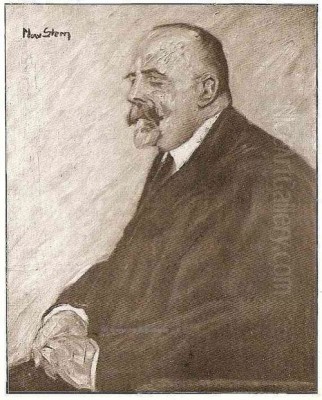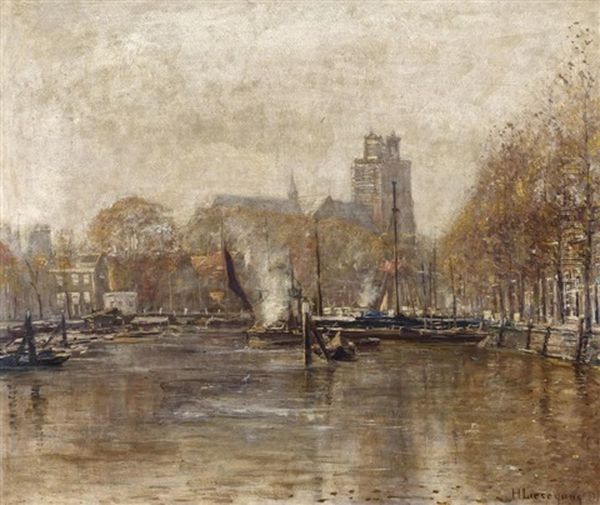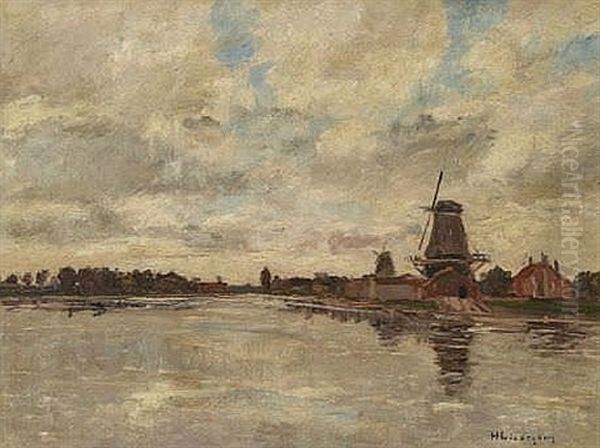
Helmuth Liesegang stands as a notable figure in German art history, particularly recognized for his contributions as a landscape painter during the late nineteenth and early twentieth centuries. A German national, Liesegang dedicated much of his artistic career to capturing the nuanced beauty of the natural world, with a particular affinity for the landscapes of the Netherlands and his native Germany. His work, primarily executed in oils, reflects the artistic currents of his time while maintaining a distinct focus on atmosphere, detail, and the interplay of light and shadow. Associated with the vibrant art scene of Düsseldorf, Liesegang's legacy is preserved through his evocative paintings and the historical records of his interactions within the artistic community.
Early Influences and the Parisian Experience
The formation of an artist is often shaped by pivotal experiences and encounters. For Helmuth Liesegang, a significant journey to Paris in the spring of 1885 proved instrumental. He undertook this educational trip alongside fellow painter Janssen van der Cule, who is also sometimes referred to as Johan van der Velden. Paris, then the undisputed center of the Western art world, offered a wealth of inspiration and learning opportunities.
During their stay, Liesegang and van der Cule immersed themselves in the city's artistic offerings. They visited an exhibition showcasing the works of the acclaimed French painter Jules Bastien-Lepage. Bastien-Lepage was known for his naturalist style, often depicting rural life with a sense of realism and emotional depth. Exposure to his work likely impressed upon Liesegang the importance of direct observation and the potential for finding profound subjects in everyday scenes.
Furthermore, they explored the Spring Salon (Salon de Printemps), a major annual exhibition that featured a wide array of contemporary art. The source material notes that the works displayed there often focused on themes of daily life. This experience would have exposed Liesegang to the prevailing trends in French art, including Naturalism and the lingering influences of Realism and Impressionism, broadening his artistic horizons beyond his German training. This Parisian sojourn undoubtedly enriched Liesegang's perspective and likely influenced his subsequent approach to landscape painting.
Rooted in Düsseldorf

While the Parisian experience was formative, Helmuth Liesegang's artistic identity remained closely tied to Düsseldorf. This city on the Rhine had been a major center for art education and production since the early 19th century, famed for the Düsseldorf School of painting. Liesegang was an active participant in the city's artistic life, notably as a member of the Düsseldorf Artists' Club (Düsseldorfer Künstlerverein or possibly the "Malkasten").
His involvement with the club included participation in its activities, such as print exhibitions held towards the end of the nineteenth century. Records indicate he supported the production of four prints associated with the club, suggesting a collaborative spirit and engagement with graphic arts alongside his painting practice. While the specifics of his role in these print projects are not detailed, his participation underscores his integration into the local network of artists.
The Düsseldorf School itself was renowned for its landscape painting, initially characterized by detailed, often romantic or heroic, depictions of nature. Key figures associated with its earlier development include Johann Wilhelm Schirmer and Carl Friedrich Lessing. Later generations, including the celebrated brothers Andreas Achenbach and Oswald Achenbach, brought new perspectives, with Andreas known for his dramatic seascapes and Oswald for his sun-drenched Italian scenes. Although operating slightly later, Liesegang worked within this rich tradition, likely absorbing influences from predecessors like Eugen Dücker, a prominent landscape painter and professor at the Düsseldorf Academy known for his coastal scenes.
Signature Style: Landscapes and Light
Helmuth Liesegang carved his niche primarily as a landscape painter. His oeuvre demonstrates a particular fascination with the scenery of the Netherlands, a subject he returned to frequently. Dutch landscapes, with their characteristic flat terrain, expansive skies, waterways, and iconic windmills, offered fertile ground for his artistic explorations. Works like his Dutch landscape from 1920 exemplify this focus.
His paintings often feature elements intrinsic to these locales: windmills standing sentinel against the horizon, tranquil rivers reflecting the sky, and scenes imbued with specific atmospheric conditions. He demonstrated a keen ability to capture the mood of a place, whether it be the crisp light of a clear day or the diffused ambiance of mist or twilight. The painting titled Nebliger Herbstmorgen (Dordrecht) (Foggy Autumn Morning (Dordrecht)) explicitly points to his interest in rendering atmospheric effects, depicting the soft light and obscured forms of dawn in the Dutch city.

Liesegang worked predominantly in oils, a medium that allowed for rich color and detailed rendering. His style is generally characterized by careful attention to detail and a skillful handling of light and shadow to create depth and realism. While grounded in observational accuracy, his works often evoke a sense of tranquility and a deep appreciation for the natural and rural environment. He captured not just the topography, but the feeling of the landscapes he depicted.
A Portfolio of Scenes
Helmuth Liesegang's body of work includes numerous landscapes that showcase his characteristic style and thematic interests. Several specific pieces provide insight into his artistic output:
Kapelle am Stadtrand (Chapel on the Outskirts): This work, measuring 51 x 58 cm, was produced as a limited edition of 50, suggesting it held some significance or popularity. The title points to a scene blending rural or suburban elements with architecture, a common theme in landscape traditions.
Nebliger Herbstmorgen (Dordrecht) (Foggy Autumn Morning (Dordrecht)): Measuring 60 x 80 cm, this painting captures a specific time and atmosphere – the quiet emergence of dawn in the Dutch city of Dordrecht, shrouded in autumnal mist. It highlights his skill in portraying subtle light and weather conditions.
Flusslandschaft mit Windmühlen (River Landscape with Windmills): At 42.5 x 56.5 cm, this title clearly indicates a quintessential Dutch or Lower Rhine scene, combining two of Liesegang's favored motifs: rivers and windmills. Such works often explore the relationship between human structures and the natural environment.
Frau an Flussufer in herbem Frühling (Woman on Riverbank in Harsh Spring): This painting (34.5 x 44.5 cm) introduces a human figure into the landscape, possibly adding a narrative or contemplative element. The description "harsh spring" suggests a depiction of nature during a transitional, perhaps less idyllic, season, showcasing a broader range of landscape interpretations.
Dutch landscape (1920): A broadly titled work confirming his dedication to Dutch scenes well into his mature career.
Scene described as "Windmill Fisherman": Although perhaps not a formal title, one description mentions a painting ("HLiesegang, Helmuth") depicting a fisherman returning home, standing in his boat, with a prominent windmill nearby. This evokes a narrative of rural life intertwined with the characteristic Dutch landscape.
These examples illustrate Liesegang's consistent focus on landscape, his interest in specific locations like Dordrecht and the Dutch countryside, and his ability to render both broad vistas and specific atmospheric moments.
Artistic Circles and Connections
An artist's development is rarely solitary. Helmuth Liesegang operated within a network of family, colleagues, and the broader art world. His family, the Liesegangs, appears to have had artistic inclinations, as sources mention Eugen Liesegang and Hermann Heinrich Liesegang as fellow artists, possibly brothers or other relatives, suggesting a supportive or shared creative environment.
His journey to Paris with Janssen van der Cule / Johan van der Velden and their shared experience viewing works by Jules Bastien-Lepage represent a crucial interaction with contemporary art beyond Germany. This exposure connected him directly to the naturalist trends prominent in France. Within Düsseldorf, his membership in the Artists' Club placed him in regular contact with local painters and printmakers.
While direct collaborations aren't extensively documented in the provided sources, Liesegang worked during a period of rich artistic activity. He would have been aware of, and likely interacted with, other artists associated with the Düsseldorf School or landscape painting in general. Figures like Max Clarenbach, a later prominent Düsseldorf landscape painter known for his impressionistic style, were part of the succeeding generation in the city. The legacy of earlier Düsseldorf masters like Andreas and Oswald Achenbach, Eugen Dücker, Wilhelm Sohn (a significant figure painter and professor), and even the foundational landscape artists like Schirmer and Lessing, formed the backdrop against which Liesegang developed his own practice. Furthermore, the broader European context included influential landscape traditions, such as the French Barbizon School, with artists like Jean-Baptiste-Camille Corot and Charles-François Daubigny, whose emphasis on capturing light and atmosphere resonated across the continent.
Enduring Impressions: Legacy and Remembrance
Assessing the full impact and legacy of Helmuth Liesegang requires acknowledging his position within the specific context of German landscape painting in the late 19th and early 20th centuries. He was a dedicated practitioner of the genre, contributing a body of work focused on capturing the essence of German and particularly Dutch landscapes. His paintings, characterized by their detail, atmospheric sensitivity, and often tranquil mood, represent a continuation and personal interpretation of the Düsseldorf landscape tradition.
While the provided information doesn't point to widespread, transformative influence on the scale of major avant-garde figures, his work was clearly valued within his circles and has been preserved in collections and records. A significant aspect of his remembrance comes from his own family. His life and memories were documented by his son, with these writings published in a family magazine in 1972. This act of familial preservation ensures that details of his life and career endure.
It is important to distinguish Helmuth Liesegang the painter from other notable individuals with the same surname, particularly the scientist Raphael Eduard Liesegang, famous for discovering the phenomenon of periodic precipitation known as "Liesegang rings." The source materials clarify this distinction, attributing the scientific achievements correctly to Raphael Eduard, not Helmuth the artist. Similarly, mentions of significant contributions to air pollution research or literary influence found in the initial source text appear to be misattributed and do not pertain to Helmuth Liesegang the painter. His legacy rests firmly within the realm of visual arts, specifically as a skilled landscape painter of his time.
Concluding Thoughts
Helmuth Liesegang emerges from the historical record as a dedicated German artist who specialized in landscape painting. His work, often focusing on the picturesque and atmospheric qualities of Dutch and German scenery, reflects both his academic training, likely rooted in the Düsseldorf tradition, and his exposure to broader European art trends, notably through his formative trip to Paris. With a keen eye for detail and a sensitivity to light and atmosphere, he created evocative depictions of windmills, rivers, and rural scenes.
Though perhaps not a revolutionary figure, Liesegang contributed steadily to the genre, capturing specific locales like Dordrecht and the broader character of the regions he painted. His involvement in the Düsseldorf Artists' Club and his connections with contemporaries like Janssen van der Cule place him firmly within the artistic community of his era. Remembered through his surviving works and familial chronicles, Helmuth Liesegang remains a representative example of the skilled landscape painters working in Germany around the turn of the twentieth century, leaving behind a visual record of the places and moods that captured his artistic imagination.